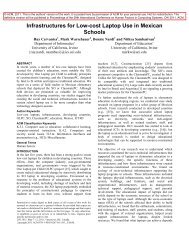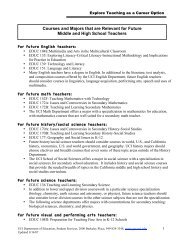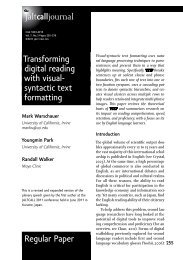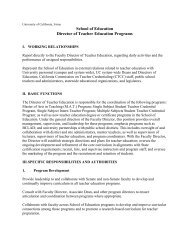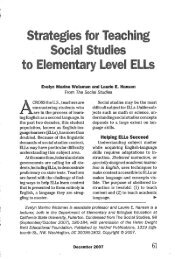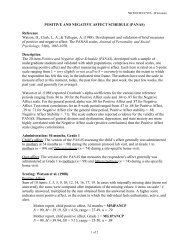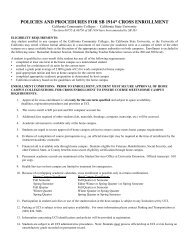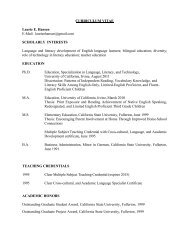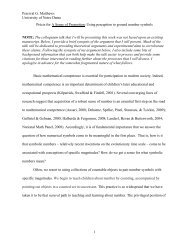290 R. KERN, P. WARE AND M. WARSCHAUERgeneration of digital natives who have grown up using the Internet andview it as an entirely ordinary environment of interaction is now enteringhigher education. What’s more, the Internet itself has changeddramatically in recent years, with the rapid spread of participatory toolsand sites facilitating social networking, interactive game playing,collaborative writing and editing, and multimodal production. Thesetools provide opportunities for students in read, write, communicate,and construct knowledge in a second or foreign language in ways thatare both new and unexplored.Although the potential role of NBLT is thus greater than ever before,research has also shown that sound pedagogy and not computers or networksper se is what really counts in NBLT. Future success will thusrequire teachers’ continued attention to the close integration of projectgoals, activity/task design, and technology interface within oftencomplex logistical realities. Teachers also need to know how NBLTcan constrain as well as enhance their students’ language use andknow when it is better not to computerize a particular activity. Thegrowing complexity of decisions involved in NBLT highlights the importanceof technology integration in both preservice and inserviceteacher education.Finally, given the rapid evolution of technologies and the fluidity ofcommunicative environments, flexibility will be a prime requirementfor teachers and researchers as they continue to explore language teachingand learning in new networked contexts. By adopting the samehabits of mind that we seek to inspire in our students—autonomouslearning; inventive thinking; and critical perspectives on the intersectionof language, technology, and culture—teachers and researcherscan help ensure that the impressive potential of network-based teachingto transform language learning is achieved.See Also: Kevin Leander and Cynthia Lewis: Literacy and InternetTechnologies (Volume 2); Steven Thorne: Computer-mediated Communication(Volume 4); Robert Blake: Distance Learning for Second andForeign Language Teaching (Volume 4); Ilana Snyder: Research Approachesto the Study of Literacy, Technology and Learning (Volume 10);Joan Kelly Hall: Language Education and Culture (Volume 1); DavidBlock: Language Education and Globalization (Volume 1); MaryKalantzis and Bill Cope: Language Education and Multiliteracies(Volume 1); Alan Rogers: Informal Learning and Literacy (Volume 2);Brian Street: New Literacies, New Times: Developments In LiteracyStudies (Volume 2); Kathy Schultz and Glynda Hull: Literacies in andOut of School in the United States (Volume 2); Carey Jewitt: MultimodalDiscourses across the Curriculum (Volume 3)
<strong>NETWORK</strong>-<strong>BASED</strong> <strong>LANGUAGE</strong> <strong>TEACHING</strong> 291REFERENCESAbrams, Z.I.: 2003, ‘The effect of synchronous and asynchronous CMC on oralperformance in German’, Modern Language Journal 87(2), 157–167.Belz, J.A.: 2003, ‘Linguistic perspectives on the development of intercultural competencein telecollaboration’, Language Learning and Technology 7(2), 68–99.Black, R.W.: 2005, ‘Access and affiliation: The literacy and composition practices ofEnglish language learners in an online fanfiction community’, Journal of Adolescentand Adult Literacy 49(2), 118–128.Blake, R.: 2005, ‘Bimodal CMC: The glue of language learning at a distance’,CALICO Journal 22(3), 497–511.Ess, C.: 2005, ‘Moral imperatives for life in an intercultural global village’, inR.J. Cavalier (ed.), The Impact of the Internet on our Moral Lives, State Universityof New York Press, Albany, NY, 161–193.Furstenberg, G., Levet, S., English, K., and Maillet, K.: 2001, ‘Giving a virtual voiceto the silent language of culture: The CULTURA project’, Language Learning andTechnology 5(1), 55–102.Herring, S.C.: 2001, ‘Computer-mediated discourse’, in D. Schiffrin, D. Tannen, andH.E. Hamilton (eds.), The Handbook of Discourse Analysis, Blackwell, Malden,MA, 612–634.Kern, R., Ware, P.D., and Warschauer, M.: 2004, ‘Crossing frontiers: New directionsin online pedagogy and research’, Annual Review of Applied Linguistics 24,243–260.Kern, R. and Warschauer, M.: 2000, ‘Theory and practice of network-based languageteaching’, in M. Warschauer and R. Kern (eds.), Network-Based Language Teaching:Concepts and Practice, Cambridge University Press, Cambridge, UK, 1–19.Kern, R.G.: 1995, Restructuring classroom interaction with networked computers:Effects on quantity and quality of language production, Modern Language Journal79(4), 457–476.Kramsch, C., A’Ness, F., and Lam, W.S.E.: 2000, ‘Authenticity and authorship in thecomputer-mediated acquisition of L2 literacy’, Language Learning and Technology4(2), 78–104.Kötter, M.: 2003, ‘Negotiation of meaning and codeswitching in online tandems’,Language Learning and Technology 7(2), 145–172.Lam, W.S.E.: 2000, ‘L2 literacy and the design of the self: A case study of a teenagerwriting on the Internet’, TESOL Quarterly 34(3), 457–482.Lam, W.S.E.: 2004, ‘Second language socialization in a bilingual chat room: Globaland local considerations’, Language Learning and Technology 8(3), 44–65.Nelson, M.E.: 2006, ‘Mode, meaning and synaesthesia in multimedia L2 writing’,Language Learning and Technology 10(2), 56–76.Ortega, L.: 1997, ‘Processes and outcomes in networked classroom interaction: Definingthe research agenda for L2 CACD’, Language Learning and Technology 1(1),82–93.Payne, J.S. and Whitney, P.J.: 2002, ‘Developing L2 oral proficiency through synchronousCMC: Output, working memory, and interlanguage development’, CALICOJournal 20(1), 7–32.Pellettieri, J.: 2000, ‘Negotiation in cyberspace: The role of chatting in the developmentof grammatical competence’, in M. Warschauer and R. Kern (eds.), Network-BasedLanguage Teaching: Concepts and Practice, Cambridge UniversityPress, Cambridge, 59–86.Reeder, K., Macfadyen, L.P., Roche, J., and Chase, M.: 2004, ‘Negotiating cultures incyberspace: Participation patterns and problematics’, Language Learning andTechnology 8(2), 88–105.



